Combine rice, vegetables, beef, sauce, and an egg together for a delightful beef bibimbap recipe made right at home.
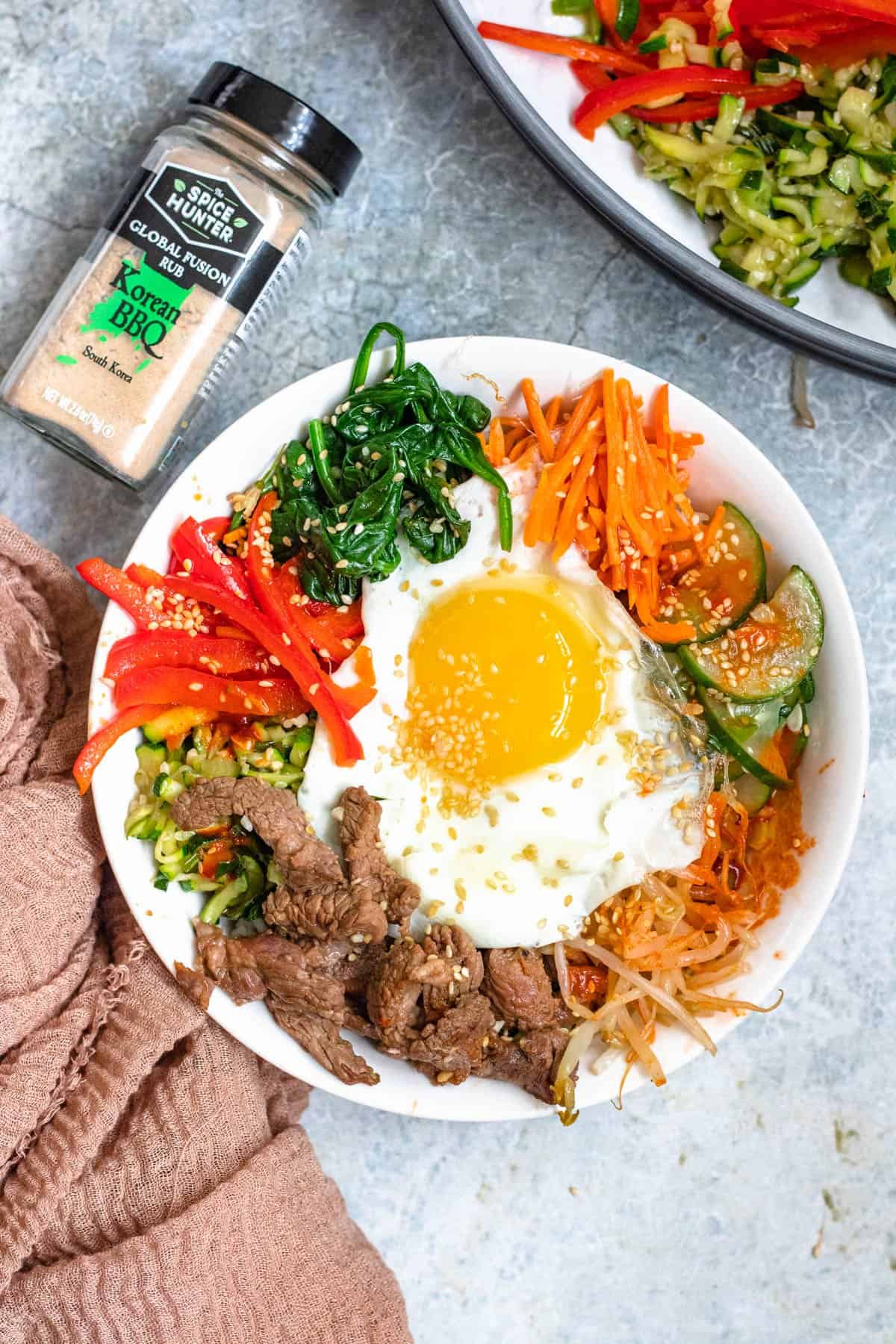
Hello Reader! I try my hardest to research recipes as best as I can before posting to ensure I am representing each culture correctly. If this recipe is from your country and I have made a mistake or you have suggestions for how to make it more authentic, I would love to hear! Please leave a comment below letting me know what should be different, and I will rework the recipe. It is always my intention to pay homage and respect to each cultural dish that I cook. Thanks for reading!
Recipe Origins
Bibimbap is a very popular Korean dish, made by layering rice, sauce, an egg, marinated beef, and multiple vegetable dishes in a bowl.
The name literally translates to mean “mixed rice”, because before the diner eats, they should mix all of the ingredients together in the bowl.
The beauty of bibimbap is the variety of flavors in the bowl. Each vegetable dish is cooked separately, leading to a gorgeous combination of complementing tastes in each bite. Though this is not a fast dish, it is ultimately a rewarding one, and I highly recommend going through the effort to make this recipe!
Why Make this Recipe?
- So Much Variety: The good thing about this Beef Bibimbap recipe is that you never need to have the same bowl twice. You can use the vegetable dishes here as a starting point, but feel free to make more or less dishes based on your tastes.
- “Travel” to Korea: Korean food is incredible and I’ve always wanted to travel to the country to experience it for myself! Unfortunately, I haven’t been able to visit yet, but I can recreate the tastes of Korea in my own kitchen!
- Unique Meal: If you’ve been feeling in a dinner rut, this is a great meal to try out! After tasting this dish, I realized that there were so many flavors I hadn’t tried before! This dish opened my eyes to a world of new and tasty flavors.
What Do I Need to Make this Recipe
Here is a visual overview of the ingredients in the recipe. Scroll down to the recipe at the bottom for quantities.
Beef Ingredients
- Steak: I used sirloin but you can also use ribeye. Cut it into very thin strips, cutting against the grain.
- The Spice Hunter’s Korean Barbecue Seasoning: I LOVE this seasoning! You can buy a bottle of it from The Spice Hunter.
- Sesame Oil: Use pure sesame oil for the best results.
Vegetables
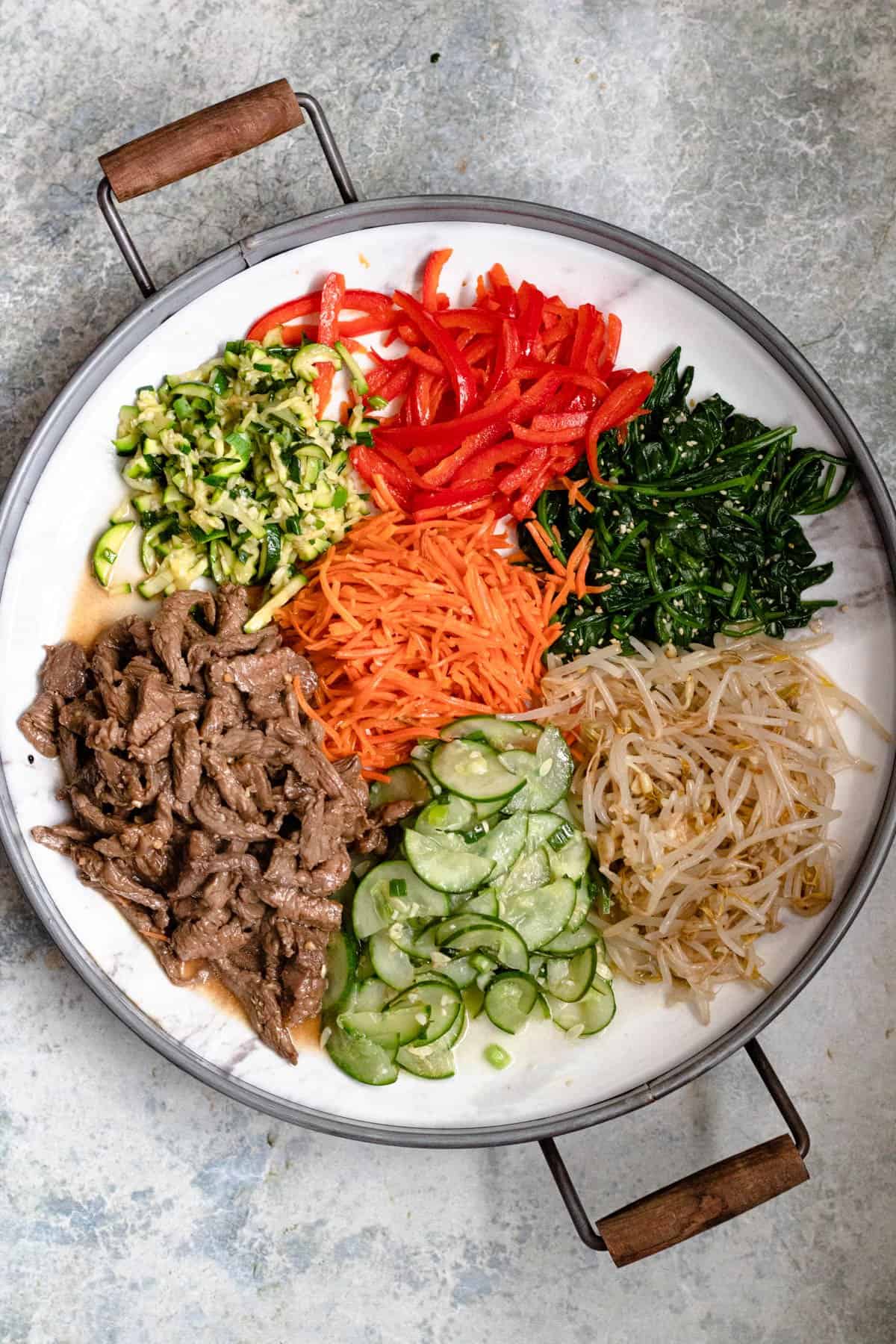
- Soybean Sprouts: Soybean sprouts can be tough to find in a local grocery store. I always buy mine from the Asian grocery store. Buy them fresh if possible, but canned will work in a pinch.
- Toasted Sesame Seeds: I bought sesame seeds in the spice aisle at the grocery store and added them to a dry pan for a few minutes until they toasted.
- Carrots: Your carrots need to be cut into matchsticks. You can do this yourself or buy a bag of already-cut matchstick carrots.
Sauce
- Gochujang: Gochujang is a thick and spicy paste made with red chili peppers and fermented soybeans. I bought mine from my local Asian grocery store.
What Other Vegetables Can I Serve with this Dish?
If you want to experiment with other vegetables on your bibimbap, try the following:
- Shiitake Mushrooms
- Korean Bellflower
- Fern Sprouts
- Caramelized Potato
- Radish
- Mung Bean Sprouts
And more!
How Do I Make this Recipe?
[adthrive-in-post-video-player video-id=”sjyK5UxS” upload-date=”2021-12-09T19:03:31.000Z” name=”Beef Bimbimbap Recipe” description=”Combine rice, vegetables, beef, sauce, and an egg together for a delightful beef bibimbap recipe made right at home.” player-type=”static”]
Step 1: Make the Beef
Mix beef with soy sauce, sesame oil, brown sugar, minced garlic, and Korean BBQ Seasoning.
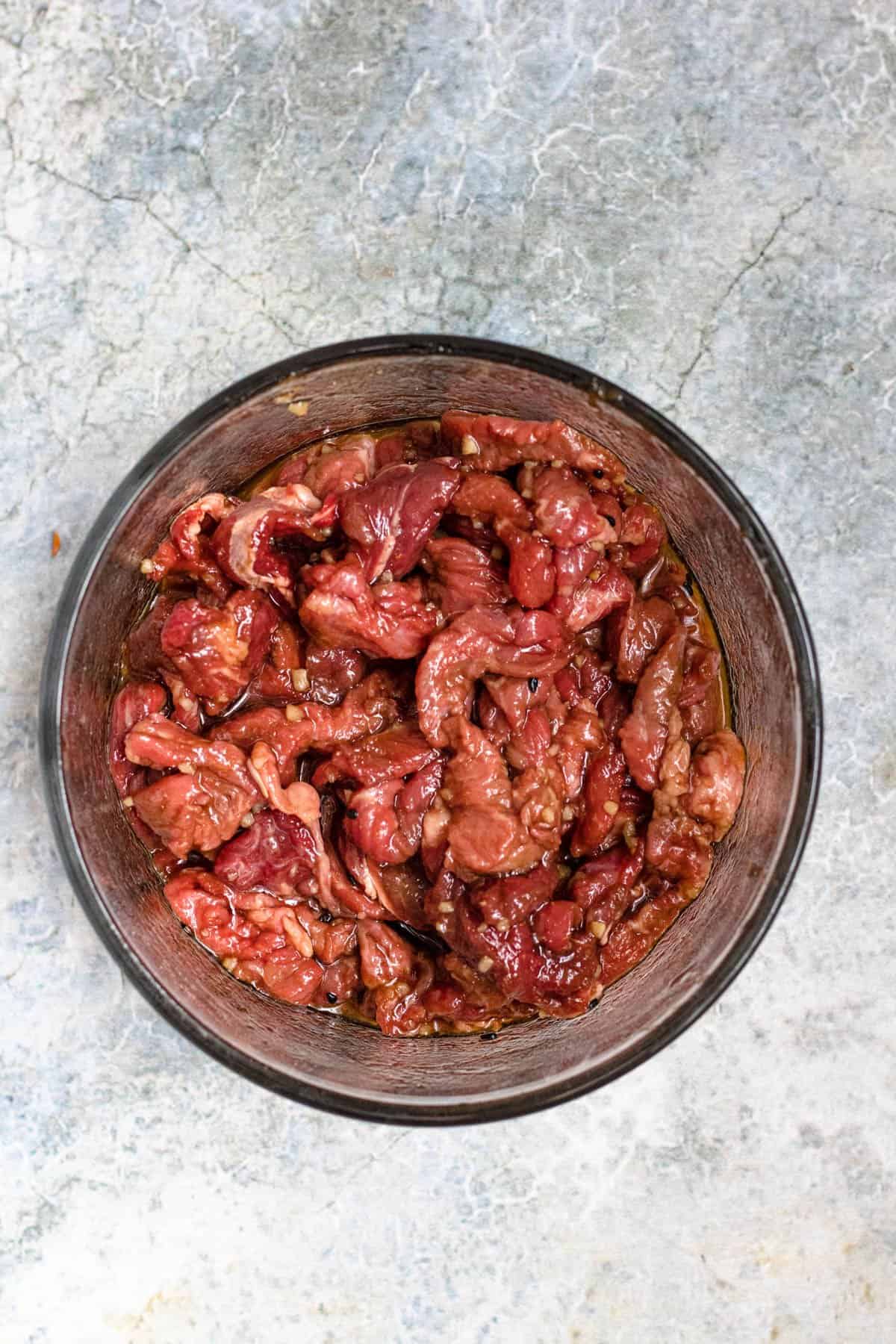
Place in a bow, cover with plastic wrap, and allow the meat to marinate in the fridge for at least 30 min (up to a few hours)
Heat a pan with vegetable oil on medium high heat. Add the marinated beef and cook, stirring occasionally, until the beef is cooked through.
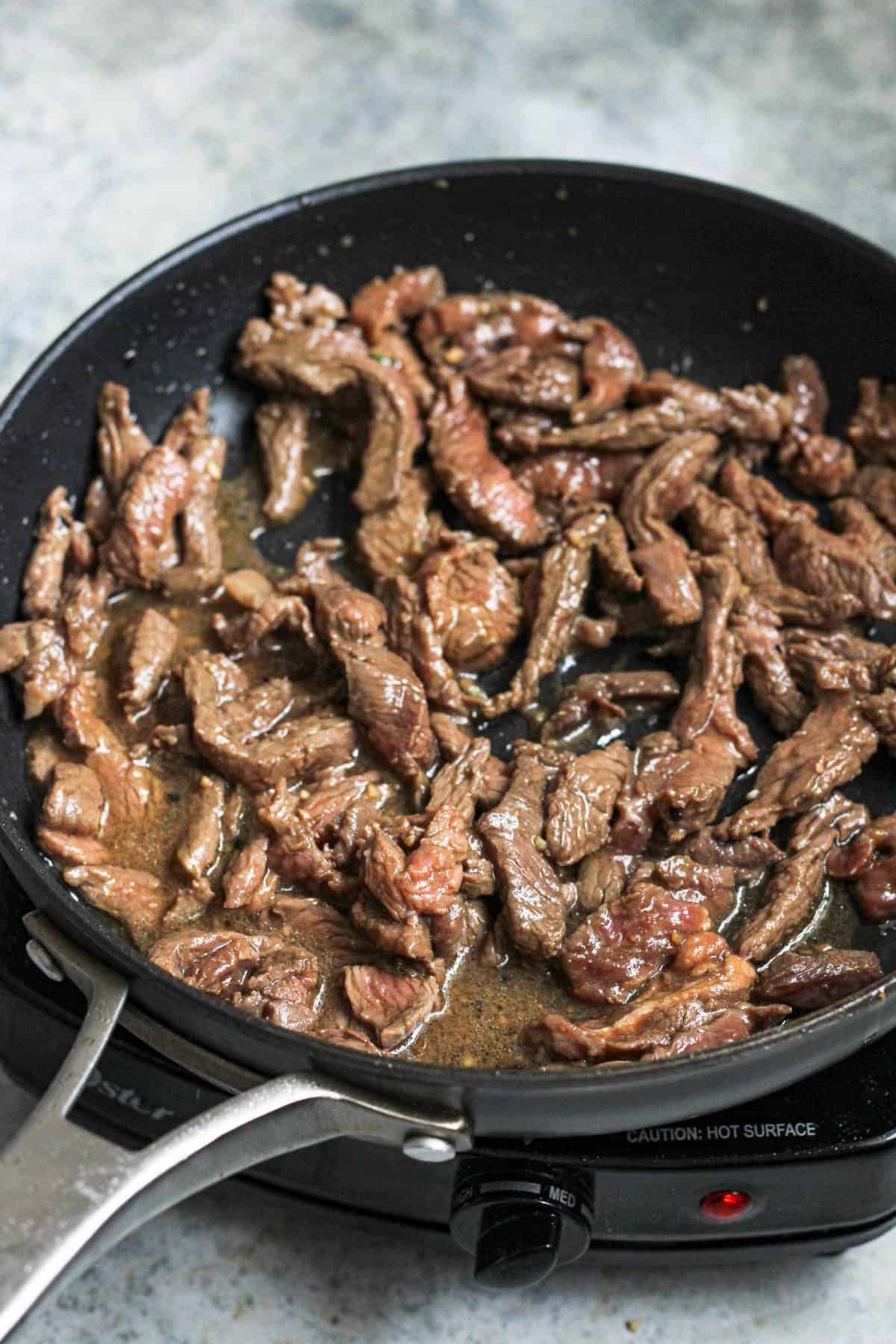
Step 2: Make the Sauce
Mix all of the sauce ingredients together in a bowl. Set aside.
Step 3: Cook the Rice
Cook the rice according to package instructions.
Step 4: Make the Vegetables
Soybeans Sprouts
Bring a medium pot of water to a boil on the stove. Add the soybeans into the water and allow them to boil for 3 minutes.
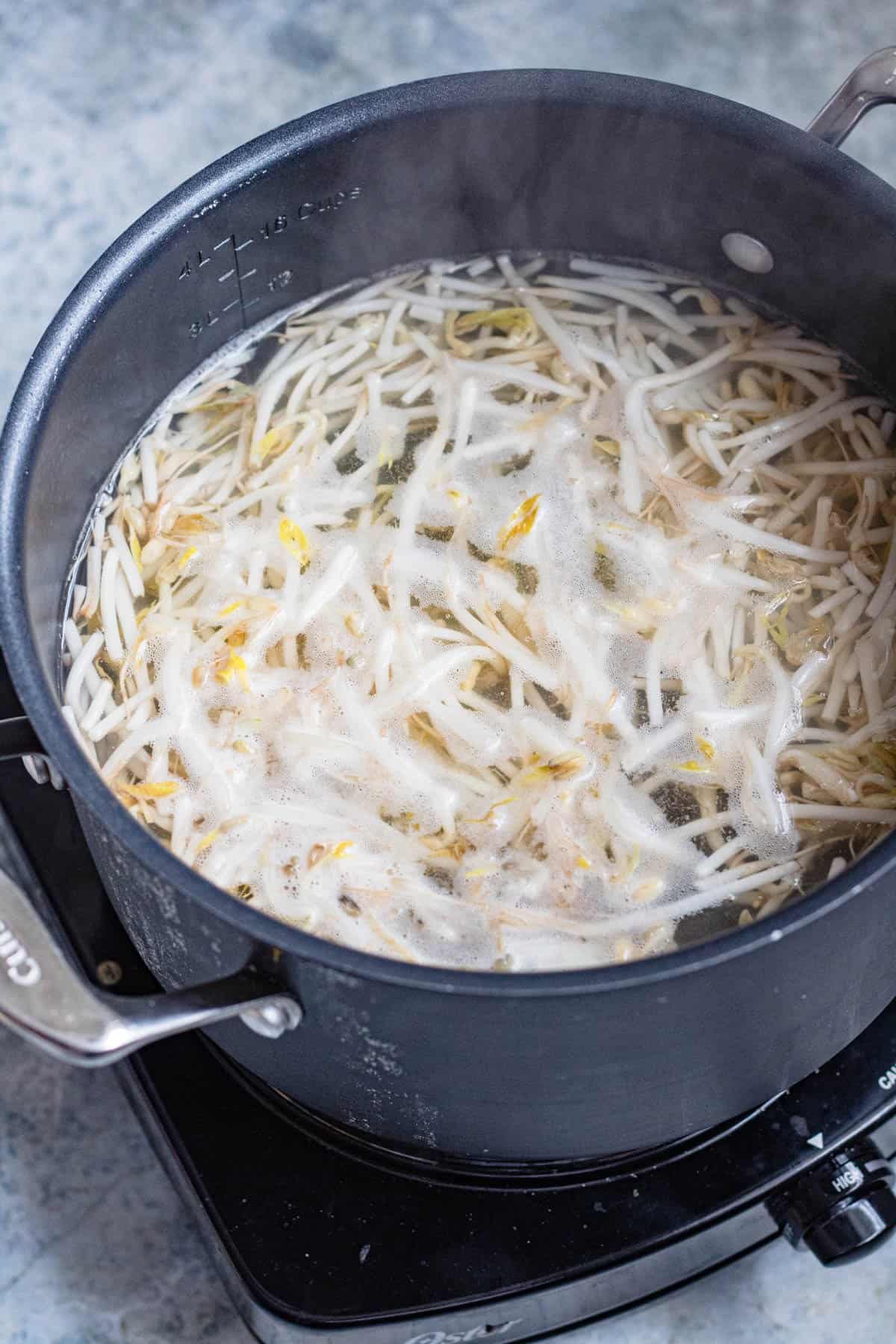
Remove the beans from the boiling water and run under cold water to stop the cooking process.
Place the bean sprouts in a bowl and mix them with the salt, garlic, and sesame oil.
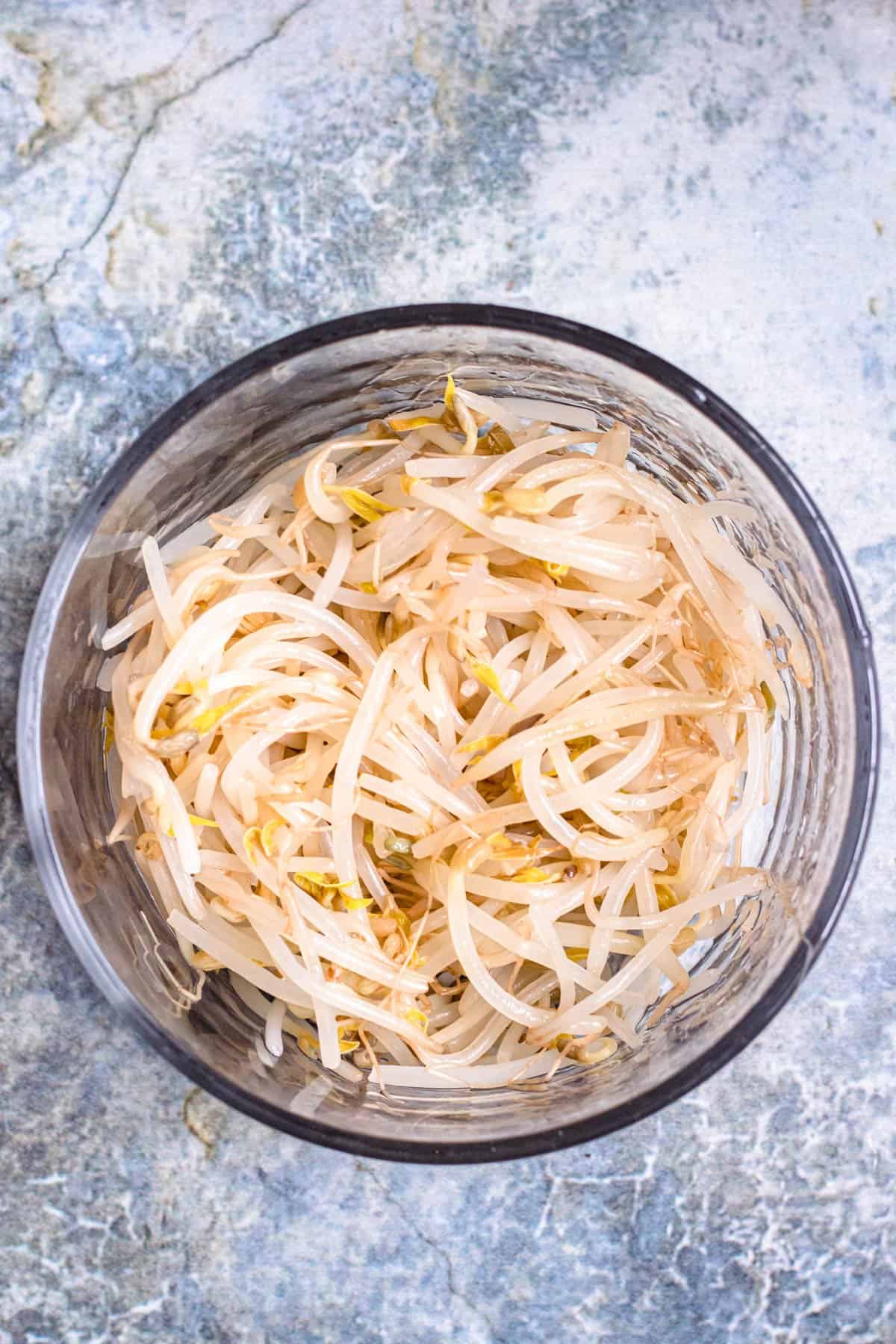
Spinach
Bring a medium pot of water to a boil.
Once boiling, add the spinach. Allow it to cook for 30 seconds in the water, then remove it.
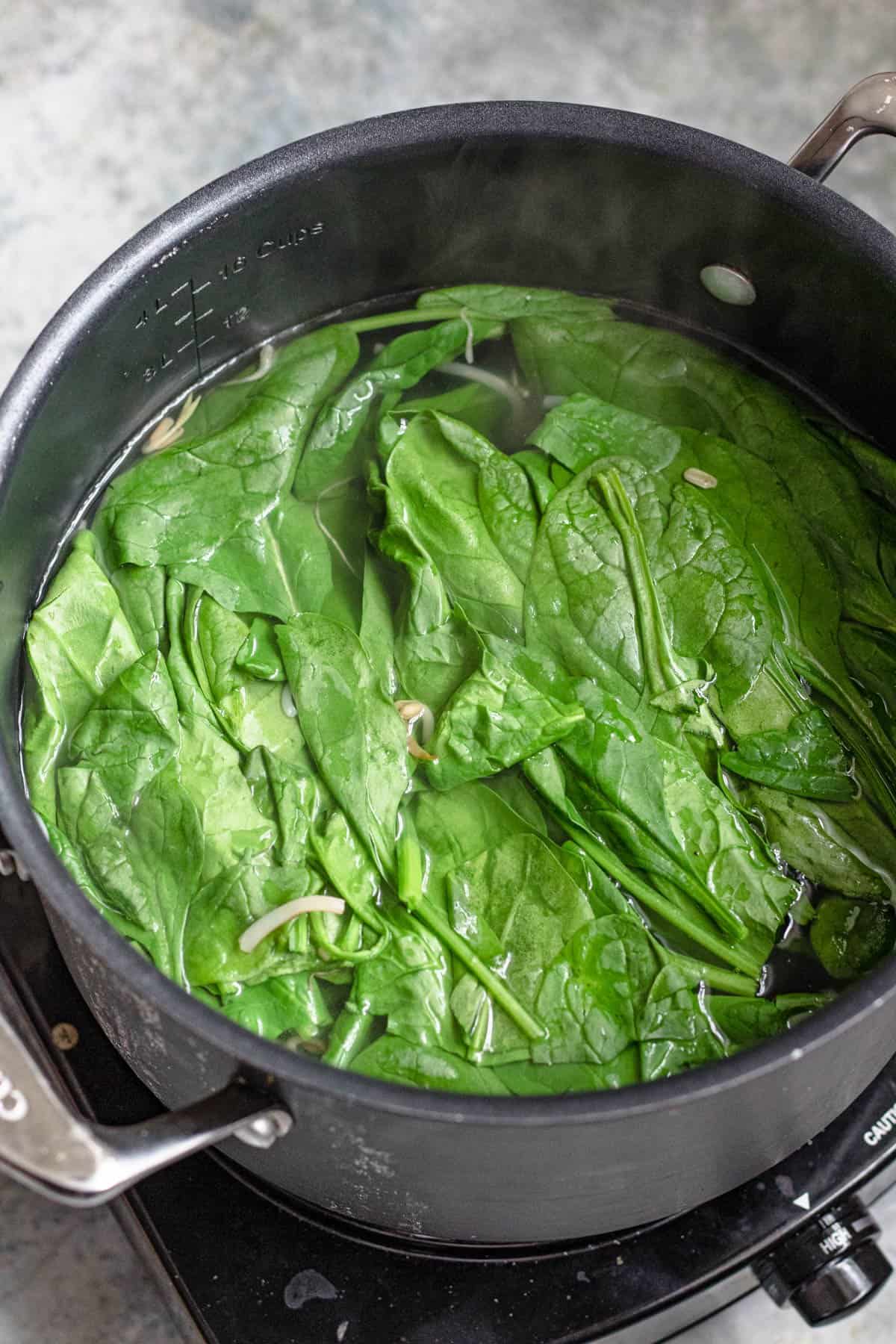
Run the spinach under cold water to stop the cooking process.
Place the spinach back in a bowl, then add garlic, sesame oil, salt, and sesame seeds.
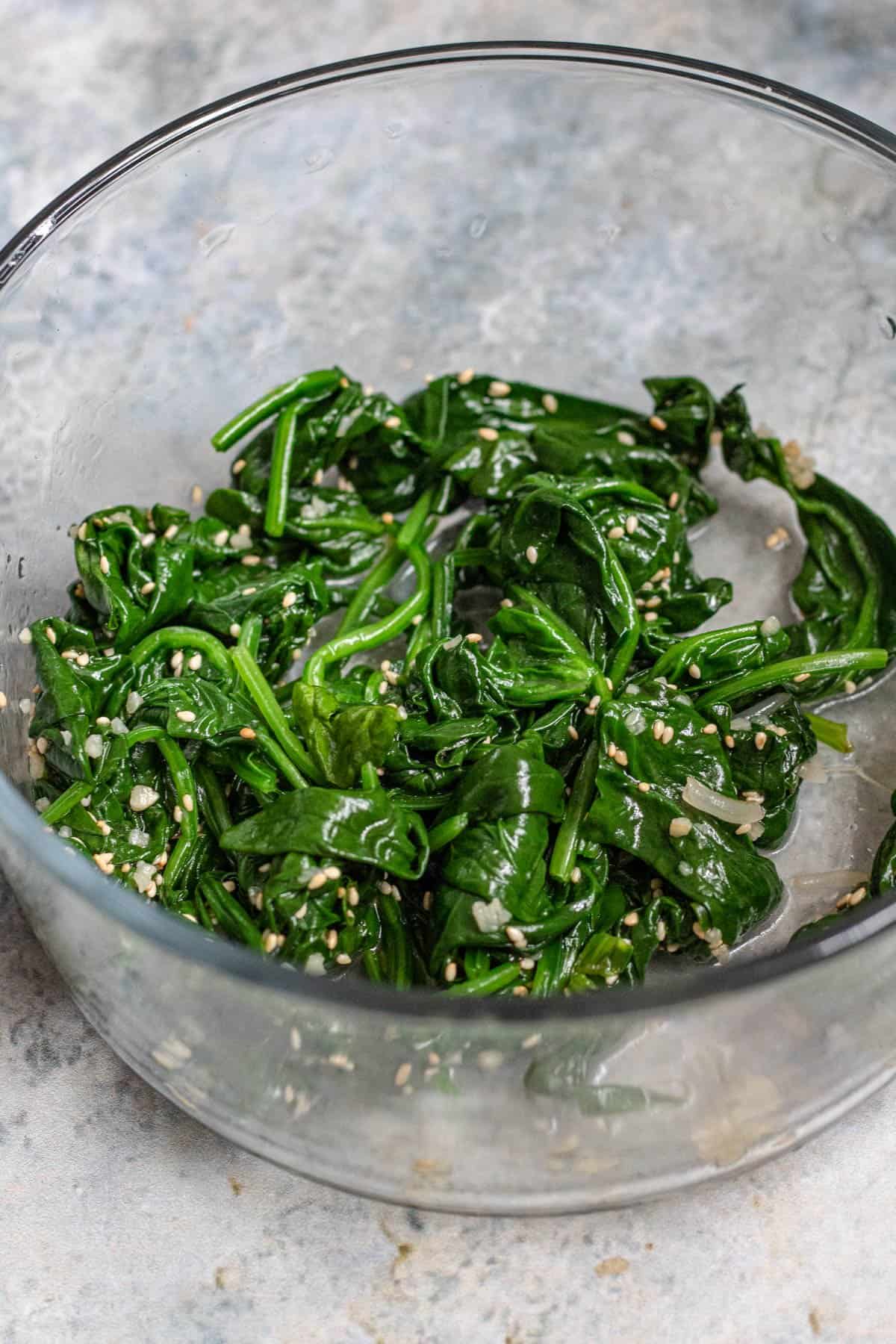
Carrots
Sprinkle the matchstick carrots with a pinch of salt. Allow to sweat for about 30 minutes. Then squeeze out the excess water.
Add vegetable oil to a pan. Add the carrots and saute until done (about 1-2 minutes).
Red Peppers
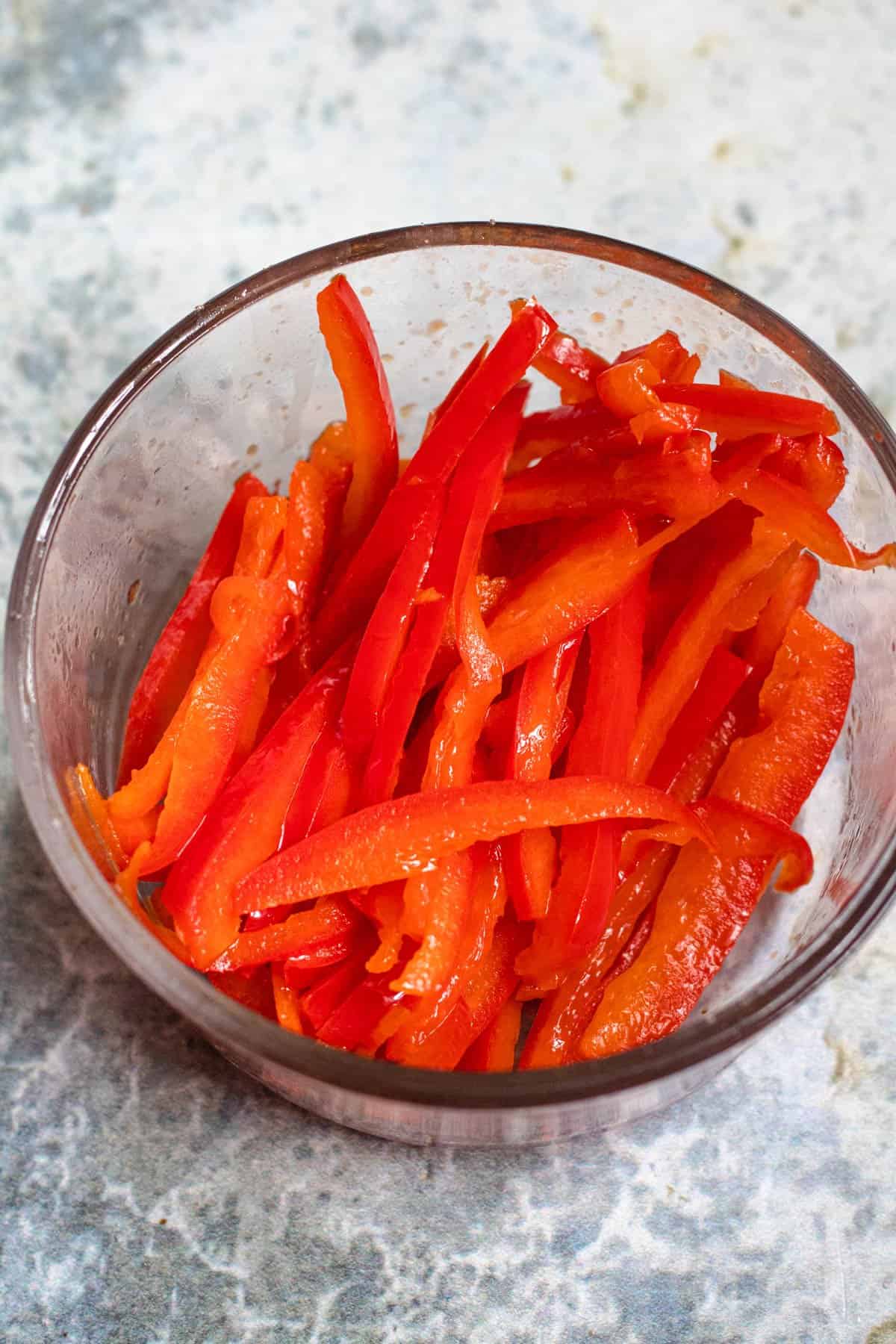
Sprinkle the red pepper with a pinch of salt. Allow to sweat for about 30 minutes. Then squeeze out the excess water.
Add vegetable oil to a pan and add the red bell pepper and salt. Cook for about 30 seconds.
Zucchini
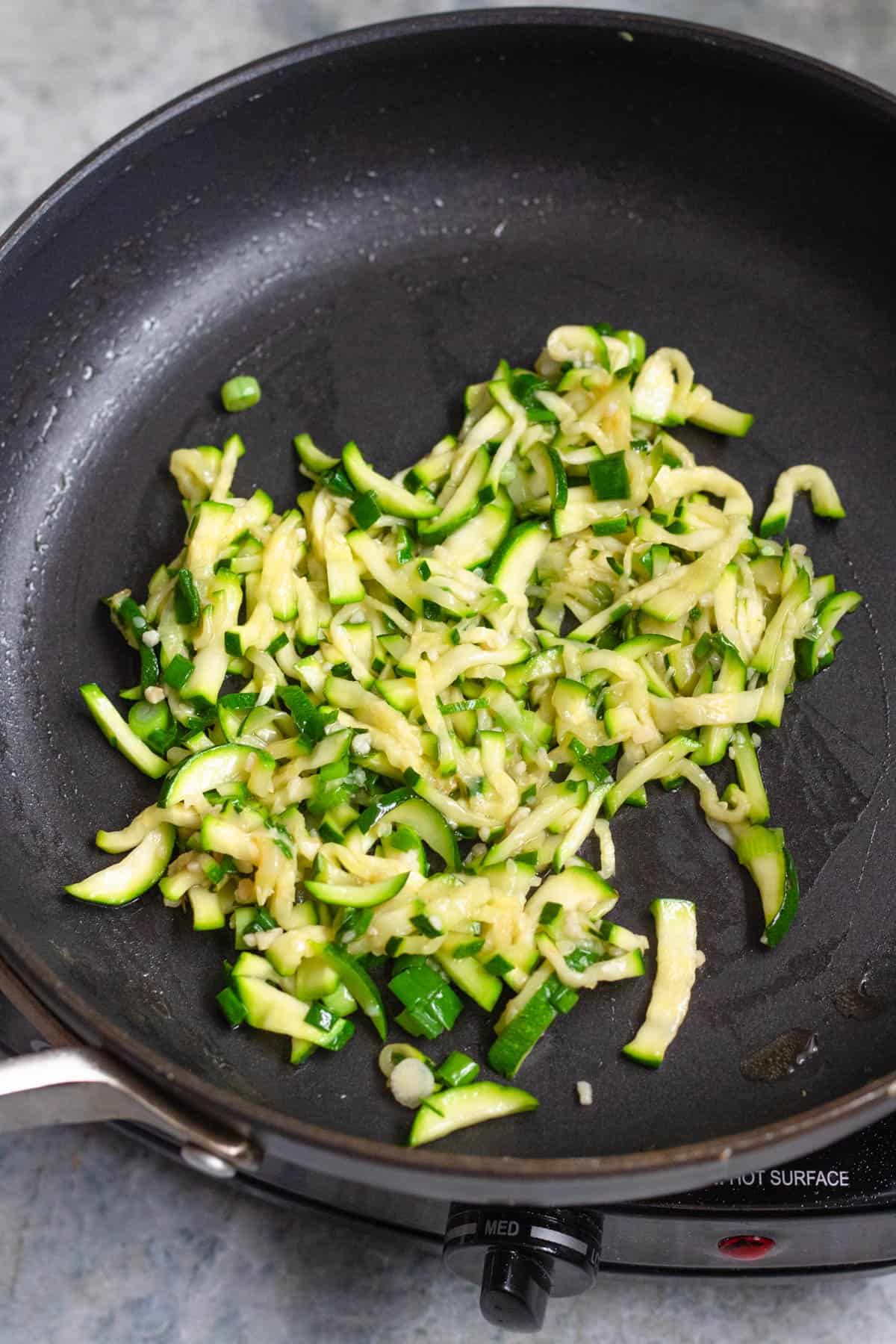
Add zucchini to a bowl and sprinkle with salt. Allow it to sweat for about 30 minutes, then squeeze out excess water.
Add the vegetable oil to a pan, then add the zucchini, garlic, sesame oil, and chopped green onion. Saute for 1-2 minutes.
Cucumbers
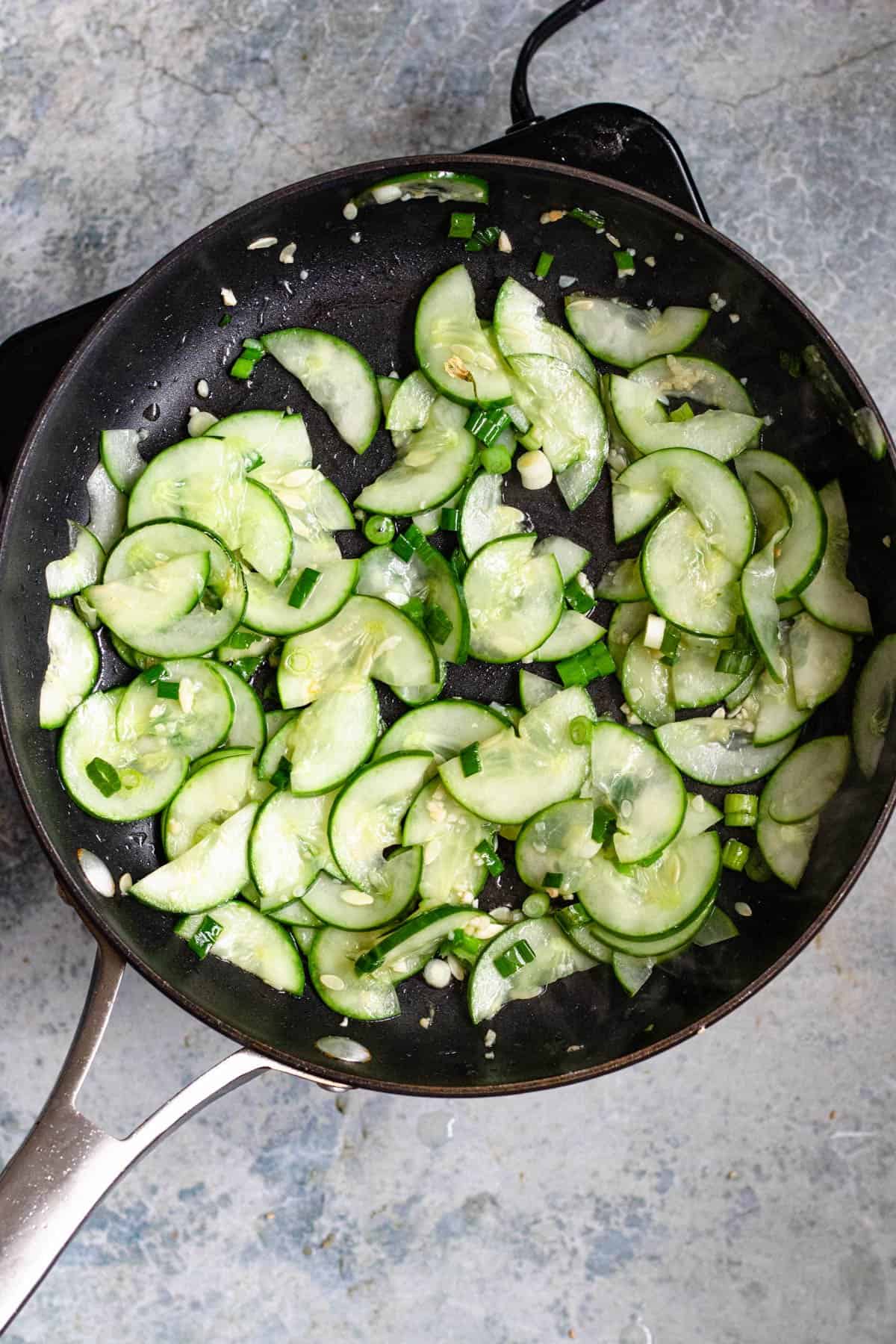
Put cucumbers in a bowl and sprinkle with salt. Allow it to sweat for about 30 minutes, then squeeze out excess water
Add vegetable oil to a pan. Add the cucumber, chopped garlic, and sesame oil. Saute until lightly cooked, about 1-2 minutes.
Step 5: Cook the Eggs
Cook the eggs sunny-side up in a pan.
Step 6: Assemble
In a bowl, layer rice, beef, some of every vegetable dish, and a sunny side up egg.
Sprinkle each bowl with toasted sesame seeds.
Enjoy!
Expert Tips
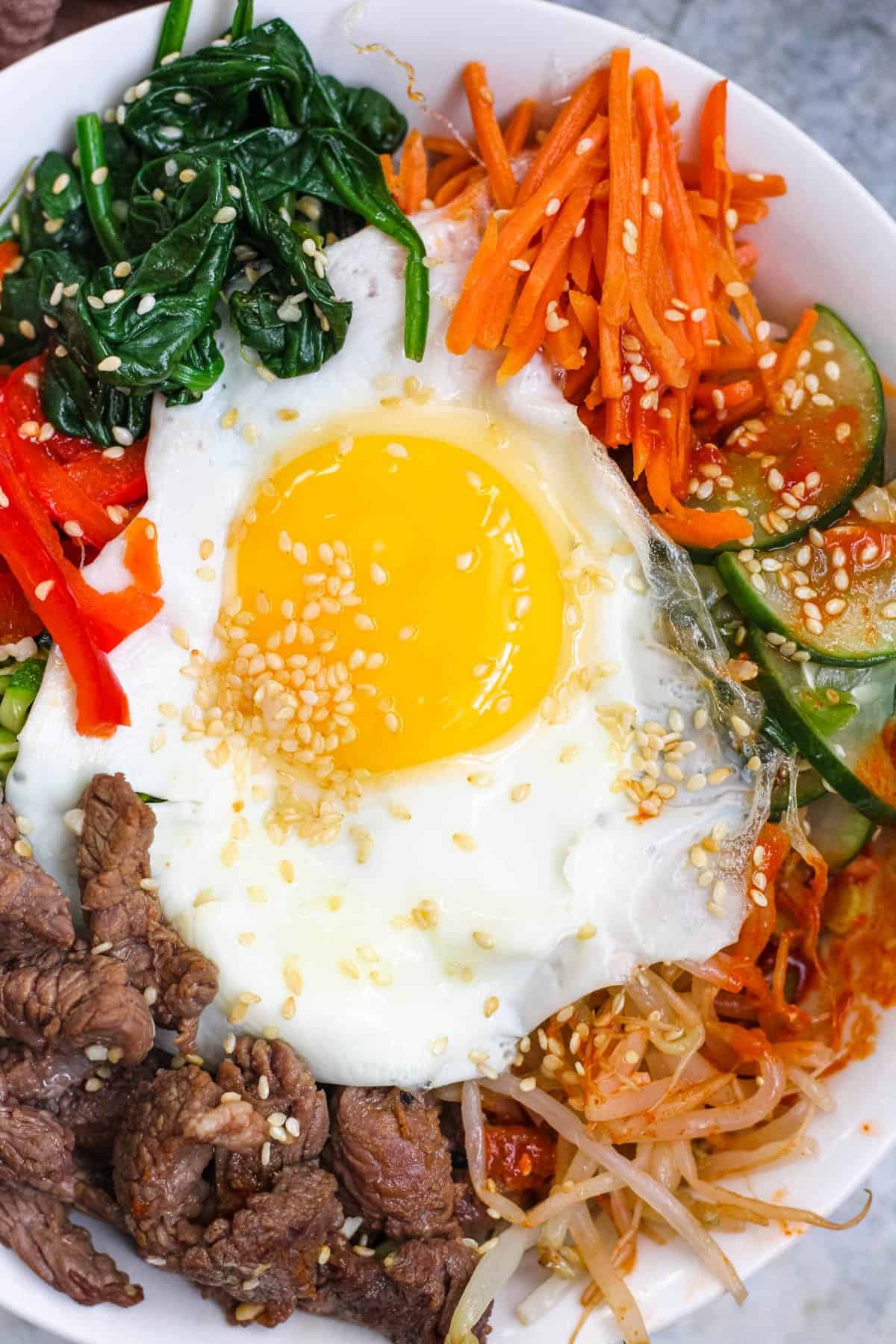
- Individually your vegetable dishes may taste a little salty, but when paired with the unseasoned rice, it adds a lot of flavor. Feel free to slightly reduce the salt if desired, but make sure to add enough that the vegetables still release their juices.
- It is very important to discard the extra liquid that the vegetables have let off after sitting in the salt. Squeeze them lightly to discard of any extra water.
- The sauce can be spicy, so allow each diner to add their own sauce to the bowl depending on their tastes.
- This dish can be a lot of work, so it is great to assemble when you already have leftovers! Make any of the vegetable dish in this recipe for dinner any night, and then use them to assemble bibimbap the next day.
- Enjoy a cold Korean Cucumber Salad as a starter to this recipe – you’ll enjoy a delightfully flavorful meal from start to finish.
Recipe FAQs
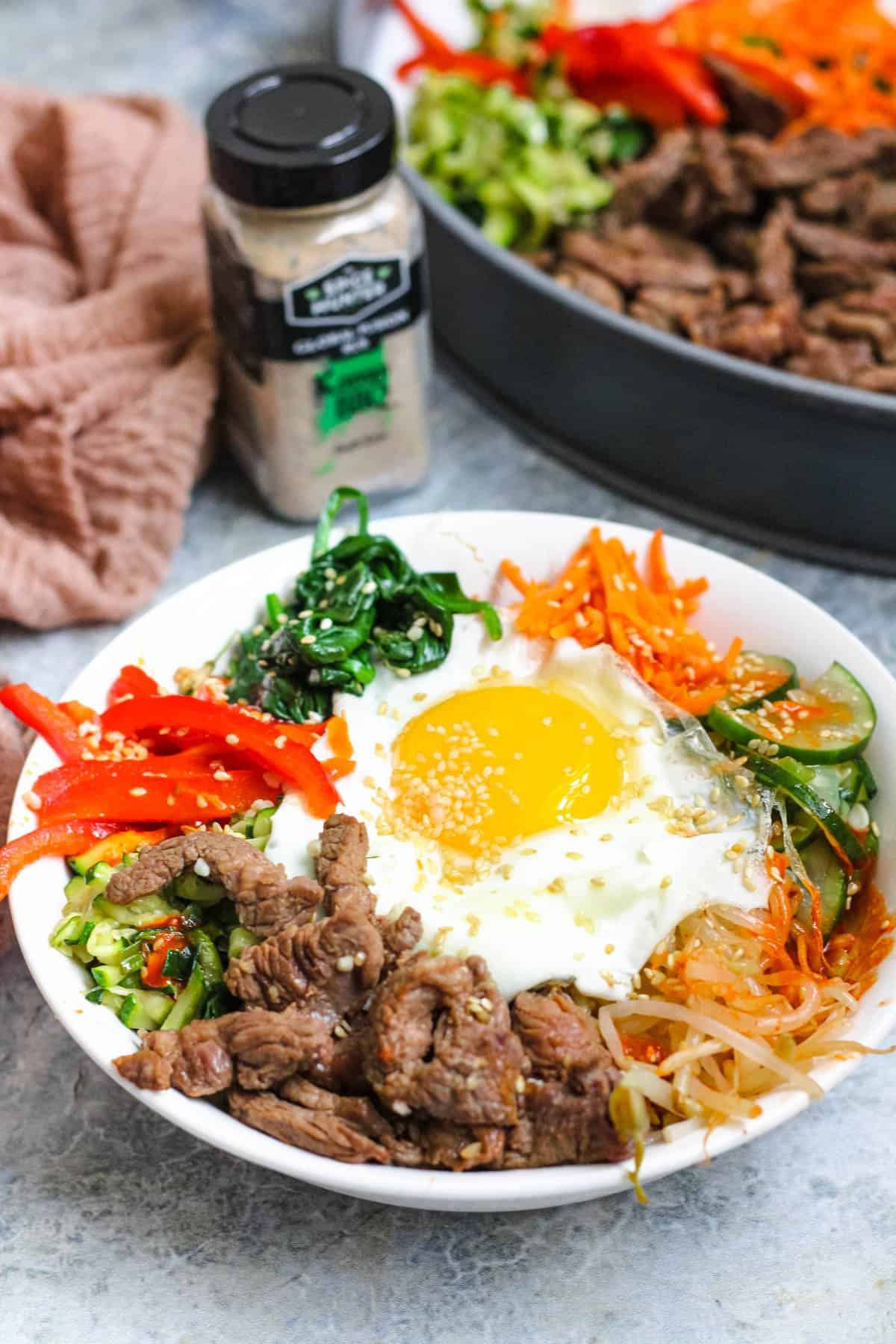
Bibimbap can be a hard word to pronounce. Phonetically, it’s spelled [bi-bim-bbap].
The “bi” makes a “bee” sound.
For ease of use, I used a frying pan to cook my beef. In addition to the frying pan, you can also use a cast iron skillet, a grill, or a wok.
The hotter you make the pan/grill before cooking the beef, the crispier the outside will be! I added all of my marinade into the pan so that it could coat the beef in a delicious sauce.
Both meals are essentially made using the same ingredients. However, Dolsot Bibimbap is served in a hot, stoneware bowl. The bowl is coated with a little bit of oil and then filled with rice. Then a variation of vegetables lie across the top of the bowl.
The stoneware bowl is put over a burner, and the rice crisps up and cooks on the bottom of the bowl. Sometimes with Dolsot Bibimbap, the meat is also put into the bowl raw, as the heat will cook the beef as the dish gets stirred.
Conversely, the Beef Bibimbap is typically served at room temperature. The rice is placed in a regular serving bowl and is not heated or crisped. The beef is also cooked before assembling the bowl as there is not enough heat to cook it after assembly.
Please keep in mind that I am not a nutritionist nor a doctor. I view bibimbap as a healthy meal because it is served with a great variety of vegetables.
Research Sources
Research done with:
Did you enjoy this recipe for Beef Bibimbap from Korea? If so, make sure to check out these other recipes I picked out just for you:
- Pigeon Peas and Rice from the Bahamas
- Kabuli Pulao from Afghanistan
- Koshari Recipe from Egypt
- Haitian Griot
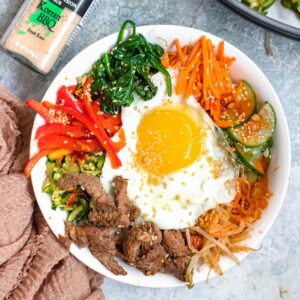
Beef Bibimbap Recipe
Equipment
- Plastic Wrap
- Mixing Bowl(s)
- Pot(s)
- Pan(s)
Ingredients
Beef Ingredients
- 1 lb Sirloin steak, cut into small strips
- 1 tbsp Soy sauce
- 1 tbsp Sesame oil
- 1 tbsp Brown sugar
- 1 tsp Minced garlic
- 1 tsp The Spice Hunter’s Korean BBQ seasoning
- 1 tbsp Vegetable oil, for cooking
Vegetable Ingredients
Soybean Ingredients
- 3 cups Soybean sprouts
- ¼ tsp Salt
- 1 tsp Garlic
- ½ tsp Sesame Oil
Spinach Ingredients
- 1 bunch Spinach, about 4-5 cups, stems cut off
- ½ tsp Garlic, minced
- ½ tsp Sesame oil
- ¼ tsp Salt
- 1 tsp Sesame seeds, Toasted
Carrot Ingredients
- 2 cups Matchstick carrots
- ¾ tsp Salt
- 1 tbsp Vegetable Oil
Red Pepper Ingredients
- 1 Red pepper, cut into thin matchsticks
- ⅛ tsp Salt
- ½ tbsp Vegetable Oil
Zucchini Ingredients
- 1 Zucchini, thinly sliced in matchsticks
- ¾ tsp Salt
- 1 tsp Garlic
- ½ tsp Sesame oil
- ½ tbsp Vegetable Oil
- 2 tbsp Green onion
Cucumber Ingredients
- 1 Cucumber, cut into half moon shapes, thinly
- ¾ tsp Salt
- 1 tsp Garlic
- ½ tsp Sesame oil
- 1 tbsp Chopped green onion
- 1 tbsp Vegetable Oil
Sauce Ingredients
- 4 tbsp Gochujang
- 1 tbsp Sesame oil
- 1 tbsp Brown Sugar
- 3 tbsp Water
Assembly Ingredients
- 4 Eggs
- 2 cups Medium grain white rice, uncooked
- Toasted Sesame Seeds, for topping
Instructions
Beef Instructions
- Mix beef with 1 tbsp soy sauce, 1 tbsp sesame oil, 1 tbsp brown sugar, 1 tsp minced garlic, and 1 tsp The Spice Hunter's Korean BBQ Seasoning. Place in a bow, cover with plastic wrap, and allow the meat to marinate in the fridge for at least 30 min (up to a few hours)
- Heat a pan with 1 tbsp vegetable oil on medium high heat. Add the marinated beef and cook, stirring occasionally, until the beef is cooked through.
Sauce Instructions
- Mix all of the sauce ingredients (4 tbsp Gochujang, 1 tbsp sesame oil, 1 tbsp brown sugar, 3 tbsp water) together in a bowl. Set aside.
Rice Instructions
- Cook 2 cups dry white rice according to package instructions.
Vegetable Instructions
Soybean Instructions
- Bring a medium pot of water to a boil on the stove. Add 3 cups soybean sprouts into the water and allow them to boil for 3 minutes.
- Remove the beans from the boiling water and run under cold water to stop the cooking process.
- Place the bean sprouts in a bowl and mix them with the ¼ tsp salt, 1 tsp garlic, and ½ tsp sesame oil.
Spinach Instructions
- Bring a medium pot of water to a boil.
- Once boiling, add the 1 bunch (4-5 cups) spinach. Allow it to cook for 30 seconds in the water, then remove it.
- Run the spinach under cold water to stop the cooking process.
- Place the spinach back in a bowl, then add ½ tsp garlic, ½ tsp sesame oil, ¼ tsp salt, and 1 tsp sesame seeds.
Carrot Instructions
- Sprinkle 2 cups matchstick carrots with ¾ tsp salt. Allow to sweat for about 30 minutes. Then squeeze out the excess water.
- Add 1 tbsp vegetable oil to a pan. Add the carrots and saute until done (about 1-2 minutes).
Red Pepper Instructions
- Sprinkle 1 red pepper (sliced) with a pinch (⅛ tsp) salt. Allow to sweat for about 30 minutes. Then squeeze out the excess water.
- Add ½ tbsp vegetable oil to a pan and add the red bell pepper and salt. Cook for about 30 seconds.
Zucchini Instructions
- Add 1 zucchini (thinly sliced) to a bowl and sprinkle with ¾ tsp salt. Allow it to sweat for about 30 minutes, then squeeze out excess water.
- Add ½ tbsp vegetable oil to a pan, then add the zucchini, 1 tsp garlic, ½ tsp sesame oil, and 2 tbsp chopped green onion. Saute for 1-2 minutes.
Cucumber Instructions
- Put 1 cucumber (thinly sliced in a half moon shape) in a bowl and sprinkle with ¾ tsp salt. Allow it to sweat for about 30 minutes, then squeeze out excess water
- Add 1 tbsp vegetable oil to a pan. Add the cucumber, 1 tsp minced garlic, 1 tbsp chopped green onion, and ½ tsp sesame oil. Saute until lightly cooked, about 1-2 minutes.
Assembly Instructions
- Cook 4 eggs sunny side up in a pan.
- In a bowl, layer rice, beef, some of every vegetable dish, and a sunny side up egg.
- Sprinkle with toasted sesame seeds.
Notes
- Steak: I used sirloin but you can also use ribeye. Cut it into very thin strips, cutting against the grain.
- The Spice Hunter’s Korean Barbecue Seasoning: I LOVE this seasoning! You can buy a bottle of it from The Spice Hunter.
- Sesame Oil: Use pure sesame oil for the best results.
- Soybean Sprouts: Soybean sprouts can be tough to find in a local grocery store. I always buy mine from the Asian grocery store. Buy them fresh if possible, but canned will work in a pinch.
- Toasted Sesame Seeds: I bought sesame seeds in the spice aisle at the grocery store and added them to a dry pan for a few minutes until they toasted.
- Carrots: Your carrots need to be cut into matchsticks. You can do this yourself or buy a bag of already-cut matchstick carrots.
- Gochujang: Gochujang is a thick and spicy paste made with red chili peppers and fermented soybeans. I bought mine from my local Asian grocery store.
- Individually your vegetable dishes may taste a little salty, but when paired with the unseasoned rice, it adds a lot of flavor. Feel free to slightly reduce the salt if desired, but make sure to add enough that the vegetables still release their juices.
- It is very important to discard the extra liquid that the vegetables have let off after sitting in the salt. Squeeze them lightly to discard of any extra water.
- The sauce can be spicy, so allow each diner to add their own sauce to the bowl depending on their tastes.
- This dish can be a lot of work, so it is great to assemble when you already have leftovers! Make any of the vegetable dish in this recipe for dinner any night, and then use them to assemble bibimbap the next day.









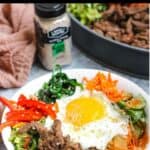
Sara says
Amazing! Easy to follow. Worth trying!!
The Foreign Fork says
So glad you liked it Sara! It’s a lot of steps but so worth it in the end 🙂